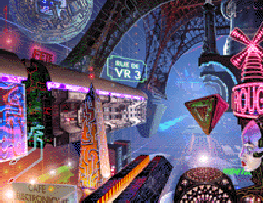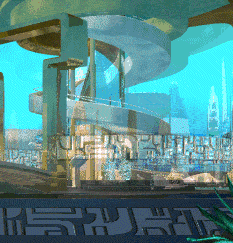"Imagine if every Thursday your shoes exploded if you tied them
the usual way. This happens to us all the time with computers, and
nobody thinks of complaining."
— Jeff Raskin, interviewed in Doctor Dobb's Journal

The technology of network intrusion has progressed by an amazing amount in the last fifteen years, creating a security hole comparable only in size to the 1970s.
Considering how rapidly international networks developed in the late TwenCen and early New Century it's a wonder that the Netcrash didn't arrive sooner than it did. Even by 2015 the complexity of networks had reached such a point that no-one person or team could accurately predict the ripple effects of any single corruption or invasion of security.
The world has been arbitrarily divided into zones of influence called Domains or Kingdoms, which is a simple way for crackers and hackers (and Gamemasters) to keep track of international regions with a similar character. These regions are listed in a convenient table format here. The sectors described here are constantly shifting, and the GM can modify them as necessary to keep players off-guard; after all, the network's transformation curve is a lot steeper than the hacker's learning curve, cause the Net's alive, cutter.
The cyberspace of Neon Twilight is a lot less flashy than the pastiche-geometry wonderland described in many other games. The Webworks is a more sinister and secretive labyrinth of secrets and back tunnels, and it doesn't look cute or colourful except in the 'soft reality' (virtual worlds) nodes. In those areas it looks more like an impossible Escher or Dali painting, but the semiotics vary according to the user. Actually, the standard appearance of the webworks is somewhat irrelevant because hackers specialize in modifying the guts of the system, not the interface. Interface is for drones — code-hacking is what it's all about.

There are no simsense interfaces or datajacks, so a hacker has to rely on fast keyboards and eye-motion laser scanners for quick input. But the speed of your interface makes no difference when you're competing against machines and Great Minds a trillion times faster in reflex and calculation than a human being. You just can't compete with an AI in real-time (something which always bothered me in other games), so a hacker mostly relies on cunning, patience, stolen/weaseled codes, paradox, human engineering, and powerful programs to invade computer systems. Infiltration is mostly a slow process that takes days or weeks, but reaps results within nanoseconds when that bank transfer to UBS is finally authorized.
The basic components of cyberspace are as follows:
- Domains - the basic global regions
- Grids - the major city centres with the most traffic
- Clusters - affiliated computer systems
- Systems - independent computers
- Nodes - specialized parts of a computer system
Which brings us down to the smallest parts, files. Here is the
very detailed information about
files , which is most useful to a GM.
Files in most ways behave as they do today, except that they
have many more 'attributes' (such as place of origin, modifications,
and time stamps) and they are linked to untold numbers of other
files.
![]()
Webworks
After the Netcrash, the designers of the Webworks decided to proceed
to a new, and infinitely more complex, level of defence for the
computer networks of the future. Starting in 2024 under the
Reconstruction regime they began to 'regrow' the Net using adaptive
procreative algorithms under the Network/Spatial Hierarchy (pronounced 'nysh'),
which quickly began to fill the hardware with an incredible number of
new and exotic programs. The designers created the
basis for a living organism to supplant the rigid structure of the
old network, an organism which would grow itself, heal itself, and
defend itself when attacked. The most popular analogy was to that
of a human immune system, with antibodies, regenerative red blood
cells, arteries/veins/dendrites, and a somewhat rigid 'skeleton'
of physical photonic-hardware systems combined with new developments
in biochips. The resulting Webworks was initially a poor replacement
as countless program 'nodules' jostled for space and clock-cycles,
slowed down traffic in competing jurisdictions, and developed
self-referential OS standards. However, the flexibility of the basic
N/SH design enforced an evolutionary cycle which soon weeded out
the poor performers and selected for the most efficient nodules.
Programs evolved and died within seconds. Eventually the Webworks
stabilized in 2025, only to undergo a titanic shift when its
information density reached such a critical mass that it grew out
of the control of its regulators. Three years later the first
Great Mind emerged from the morass of the Webworks, unwittingly
eating most of the virtual MIT Media Lab as this newborn entity struggled
to survive.
Today the webworks channel most of humanity's entertainment, commerce,
finance, communications, research, design, and administration. The
Advanced countries use the webworks for practically everything, from
running the energy grid to picking what colour of jeans to wear this morning.
The need to stay connected to the webworks is utmost, and people disconnected
from their compads (tiny portable computers) feel naked.
Nevertheless, a tinge of suspicion remains from the days of the Netcrash,
when nothing seemed to work and faith in computers was shattered. This
mild suspicion has been fed in recent years by the 'birth' of uncontrolled
intelligent Great Minds whose power and freedom scare people used to
believing that all machines are human constructs. The fear of rogue Minds
taking control of nuclear arsenals or city comptrollers is played up by
the media in action movies and op-eds, and constantly downplayed by government experts.
In fact
the threat of renegade Great Minds is genuine, but most of their energies
have been channeled into government-sponsored activities such as industrial
espionage or counter-terrorism, and the few outside of official control have
managed to stay obscure enough to avoid media attention. What their plans
are is difficult to guage.
A note on terminology : independent programs within the webworks are known as nodules;
transmitted datum are known as signal-packets; incomplete nodules are called code blocks;
destructive nodules are known as databeasts or viruses; and subversive/intrusive nodules
are called parasites.
The security of the webworks is maintained by independent nodule antibodies (known as
defenders, guardians and many other names) whose job it is to neutralize suspicious,
anomalous, false, weak, crashed, or erratic signal-packets. Legitimate signal-packets
are very strong and capable of defending themselves from intrusion using sophisticated
chaos-cryptography. Defender-nodules have evolved in the webworks from what is known
as the 'primordial soup' in hacker parlance, but despite being independent they can
be strengthened by adding superior hardware in the domain in which they operate.
![]()
Hacking Basics
A hacker wishing to illegally enter a restricted host can take several approaches.
Basically, the options are to either a) attack the host to weaken it; b)
trick the host; c) Sneak into the host.
The first and most crude approach involves 'cracking' a system's defences, crashing
the main programs, cutting a large hole using destructive viruses or databeasts,
and then plundering the host when it is weak and on the verge of collapse. This method
has the side-effects of leaving obvious evidence, immediately alerting the operators
of the host, and possibly damaging the contained databanks beyond salvage or use by
the hacker. It is used in the most extreme circumstances when speed is critical.
The second approach involves gaining a legitimate identity within the host by
posing as a user/operator/admin. This requires the judicious use of parasite
programs which latch onto legitimate Avatars and allow the hacker to hide behind
the mask of a normal user. The success of the parasite program will determine
the status of the forged identity. A poor result would create an identity with
access to only the most basic files, while an amazing result would create a superuser
identity which could do anything. The benefit of using parasites is that once the
false identity is installed, the host will not bother you again until you switch
nodes.
The third approach involves sneaking into a host in such a manner that none of the
sensor nodules notice the intrusion. Stealth, Cloaking, Skulk and Ghost programs are
used for this purpose, and they involves hours or days of background research to
locate forgotten backdoors, misplaced loopholes, and other tricks. Once the hacker
has snuck in, he can use a variety of programs within the host. The drawback of
sneaking in is that the host is constantly searching for intruders, so the hacker
has to constantly hide (roll to hide each round).
![]()
Hacking Stuff
- Sanitation
- Vehicular Control
- Eyesats Sky Monitoring
- Power Grid - diversion, localized shutdown only
- Security Sensors
- Robotic Manufacturies
- Object Tracking & Motion
- Sensors - pressure
- Sensors - visual (visible, infrared, ultraviolet, x-ray)
- Sensors - radar, sonar, millimetre-wave, life-detectors
- Sensors - acoustic (sonar, high & low frequency, ELF)
- Sensors - Identification (geneprint, iriscans, voiceprints, neuralwaves)
- Automated Weaponry Systems
- Movement Systems - elevators, doors, gateways, screens
- Instrumentation
- Databanks - public information
- Databanks - corporate shadowfiles
- Databanks - government dossiers
- Databanks - security intelligence dossiers
- Wiretap - transmission interception & tracing
- Building Schematics - heating, cooling, ventilation, hydro
- Real Estate info
- Financial Transactions
- Mediafeed - news feeds, entertainment, vidphone
- Shadowland - underground gossip
- Drone control